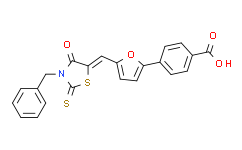| Description: |
Leukadherin-1 is a specific agonist of CR3 and the leukocyte surface integrin CD11b/CD18. |
| In Vivo: |
Leukadherin-1 decreases macrophage infiltration in the lungs during hyperoxia. Furthermore, treatment with Leukadherin-1 improves alveolarization and angiogenesis and decreases pulmonary vascular remodeling and PH. Targeting leukocyte trafficking using Leukadherin-1, an integrin agonist, is beneficial in preventing lung inflammation and protecting alveolar and vascular structures during hyperoxia[2]. |
| In Vitro: |
Leukadherin-1 (LA1) modulates natural killer (NK) cell inflammatory cytokine secretion. The SLE-associated CD11b-R77H variant does not influence NK cell response to Leukadherin-1. Leukadherin-1 does not modulate Syk activation in NK cells. Leukadherin-1 (LA1) does not modulate signal transducer and activator of transcription (STAT)-4 phosphorylation. Leukadherin-1 modulates TLR-2 and TLR-7/8-induced monocyte cytokine secretion[1]. |
| Cell Assay: |
Supernatant cytokines are quantified after stimulation and culture for 18 h (monocytes) or 24 h (NK cells). Except for bead-based stimulation, all experiments are conducted using 100 µL cells in a 96-well plate format. NK cell stimuli are added as follows: (1) Syk inhibitor (1 μM), (2) Leukadherin-1 or dimethylsulphoxide (DMSO) (vector control) (7.5 μM). Shown to induce∼82% of maximum response with negligible off-target effect, (3) anti-CD210 or isotype control (5 µg/mL), (4) 30-45 min after Leukadherin-1 NK cells are stimulated with combinations of IL-12 (10 ng/mL), IL-15 (30 ng/mL) or IL-18 (10 ng/mL): either IL-12 + IL-15 or IL-12 + IL-18. Monocytes are stimulated using pam3csk4 (TLR-2 agonist, 300 ng/mL) or R848 (TLR-7/8 agonist, 2 µg/mL). Supernatants are stored at −80ºC for < 1 month before quantification. To exclude non-specific Leukadherin-1-mediated cytotoxicity, the cell viability is assayed at 24 h using the CellTitre-Glo reagent. No significant loss of viability in comparison with the DMSO control is seen, concurring with published data in other cell types. |
| References: |
[1]. Roberts AL, et al. The complement receptor 3 (CD11b/CD18) agonist Leukadherin-1 suppresses human innate inflammatory signalling. Clin Exp Immunol. 2016 Sep;185(3):361-71.
[2]. Jagarapu J, et al. Efficacy of Leukadherin-1 in the Prevention of Hyperoxia-Induced Lung Injury in Neonatal Rats. Am J Respir Cell Mol Biol. 2015 Dec;53(6):793-801. |






















